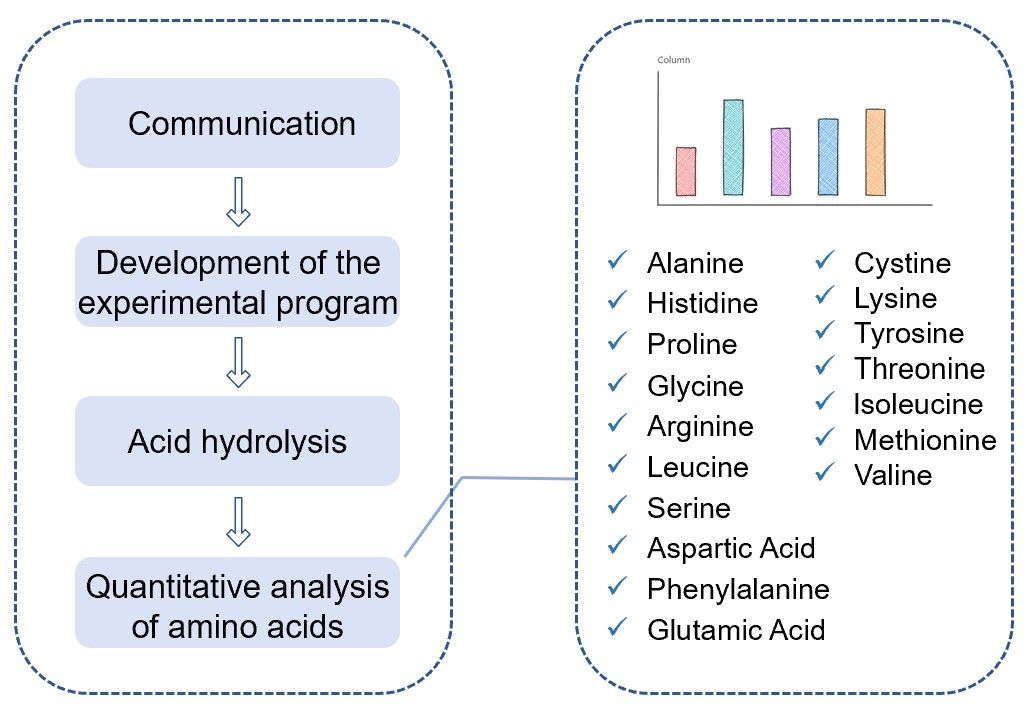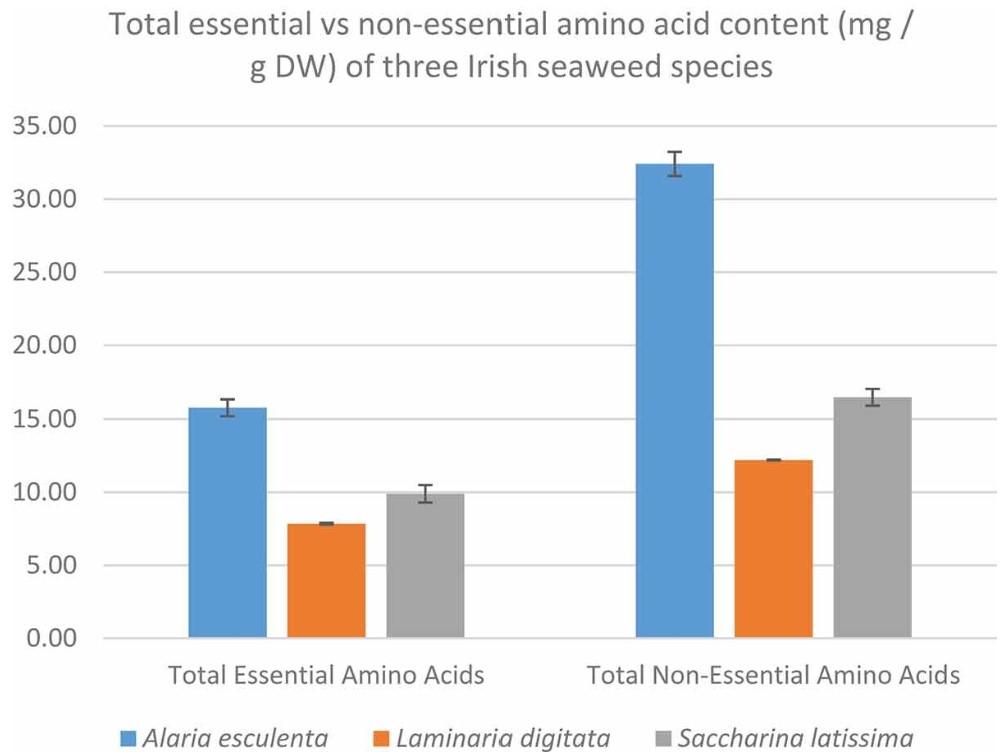Amino Acid Composition Profiling Service
Client Satisfaction with Amino Acid Qualitative and Quantitative Analysis ls Our Pursuit
Amino acid composition analysis is an effective tool for studying the value of seaweed biomass for application as a novel protein source. At Creative Biolabs, we offer a one-stop amino acid analysis for Seaweeds with high precision and accuracy. Our services apply to a wide range of seaweeds and different sample types. The content of various amino acids varies in different types of seaweed. Our methods accurately detect such differences.
 Fig.1 Detailed amino acid analysis in seaweeds.
Fig.1 Detailed amino acid analysis in seaweeds.
Seaweed contains many types of amino acids and proteins. We first hydrolyze the peptide bonds by acid to break down the proteins in the samples into amino acids. Afterwards, we quantify the amino acid composition by ion chromatography. There are differences in pre-treatment for free amino acid analysis. Since tryptophan is easily degraded during acid hydrolysis. Glutamine and asparagine are also converted to glutamic acid and aspartic acid respectively. Therefore, we only test the content of the following 17 amino acids when there is no special request from clients. As with other Amino Acid Analyses in Biomass, we have optimized the steps for amino acid analysis in seaweed. For each on-board test, we calibrate using standard sample results to determine the precision and accuracy of the test.
|
Alanine
|
Cystine
|
Histidine
|
Lysine
|
|
Proline
|
Tyrosine
|
Glycine
|
Threonine
|
|
Arginine
|
lsoleucine
|
Leucine
|
Phenylalanine
|
|
Methionine
|
Serine
|
Valine
|
Aspartic Acid
|
|
Glutamic Acid
|
-
|
-
|
-
|
Features of Seaweed Amino Acid Analysis Service
-
One-stop analytical service: We have a professional analytical team to assist in the experimental design and provide a one-stop amino acid analysis for seaweeds from protocol development, and testing to analysis.
-
Wide range of application: Our amino acid analysis methods are not only applicable to many types of seaweeds but also to many seaweed-related basic and applied researches.
-
Rich experience in seaweed analysis: Our analysts have rich experience in providing seaweed amino acid analysis solutions.
Creative Biolabs provides professional and reliable seaweed amino acid analysis services with the first goal of satisfying clients' needs. We have an experienced team for experimental design to ensure that the analysis project is completed efficiently. Welcome to contact us for more details if you are interested in our seaweed amino acid analysis service.
Published data
Seaweeds are rich in amino acids and have potential applications in the development of food substitutes, among others. Different treatments may affect the composition of seaweeds, which in turn may have an impact on their functionalized applications. In this study, the effect of dry fractionation on the amino acid and protein content of seaweeds was compared using three types of seaweeds as raw materials. The comparative results showed that fractionation had a significant effect on the content of essential amino acids, non-essential amino acids, and proteins. Fractionation may be used as a treatment method for producers to utilize seaweeds for the production of enrichment products. This study provides a demonstration for us to analyze the amino acids in seaweeds and their application value.
 Fig.2 Total amino acid content of three Irish seaweed species.1, 2
Fig.2 Total amino acid content of three Irish seaweed species.1, 2
FAQs
Q1: Why is it necessary to analyze amino acid content when analyzing the value of seaweed applications?
A1: Due to their potential health benefits, seaweeds are used for various biotechnological purposes such as cosmetics, biofuel production, and animal feed. In addition to this, seaweed is rich in amino acids and is a potential source of protein materials. Analyzing the amino acid content of seaweeds can provide valuable information about their protein content, nutritional composition, and potential applications in various industries.
Q2: Why is the content of only 17 amino acids tested?
A2: During acid hydrolysis treatment, tryptophan, glutamine, and asparagine in seaweed protein are hydrolyzed and converted into other substances. Therefore, we only test the content of 17 amino acids when there is no special request from clients.
Customer Review
Helping to Better Value Seaweeds
"We needed to analyze the amino acid content of seaweeds to help us better value them, but this was beyond our experimental capabilities. After careful consideration, we chose to work with Creative Biolabs. Their amino acid analysis service was customer-focused. After understanding our needs, they developed a detailed experimental plan. In the end, in addition to the analytical report, they also made some good suggestions for seaweed composition analysis, which helped us speed up the pace of seaweed research."
Wide Range of Analysis Services
"Our lab was mainly engaged in the in-depth exploration and application development of some seaweed active substances, so we cooperated with Creative Biolabs. Their amino acid analysis service was applied to different processed seaweed samples and was an excellent tool to help us understand the composition of seaweeds and develop seaweed applications. We look forward to continue working with them in the future."
References
-
Healy, Laura E., et al. "Impact of dry, particle-size fractionation on protein and amino acid content of three seaweed species." International Journal of Food Properties 25.1 (2022): 2073-2088.
-
Under Open Access license CC BY 4.0, without modification.
For Research Use Only.
Related Services

 Fig.1 Detailed amino acid analysis in seaweeds.
Fig.1 Detailed amino acid analysis in seaweeds.
 Fig.2 Total amino acid content of three Irish seaweed species.1, 2
Fig.2 Total amino acid content of three Irish seaweed species.1, 2



